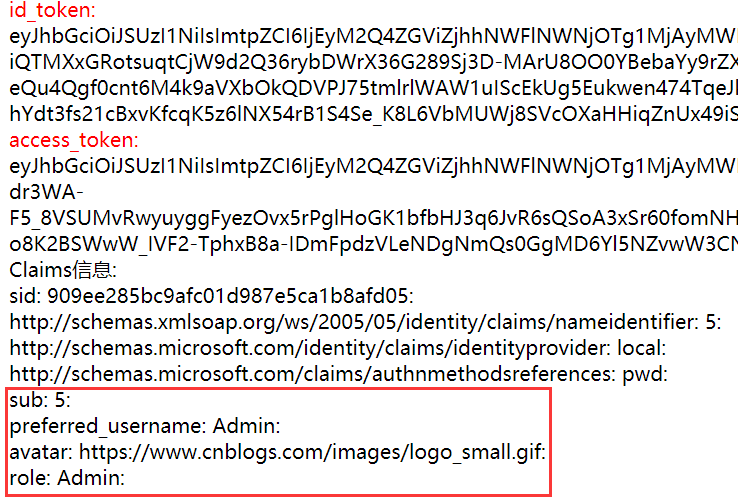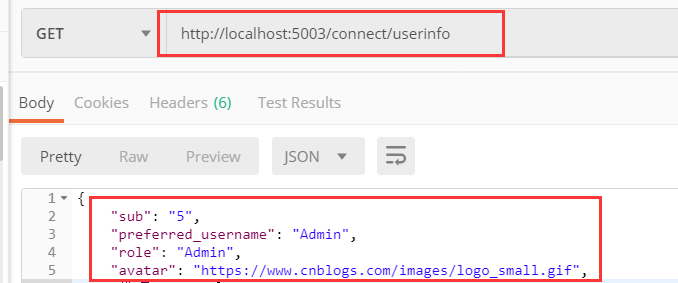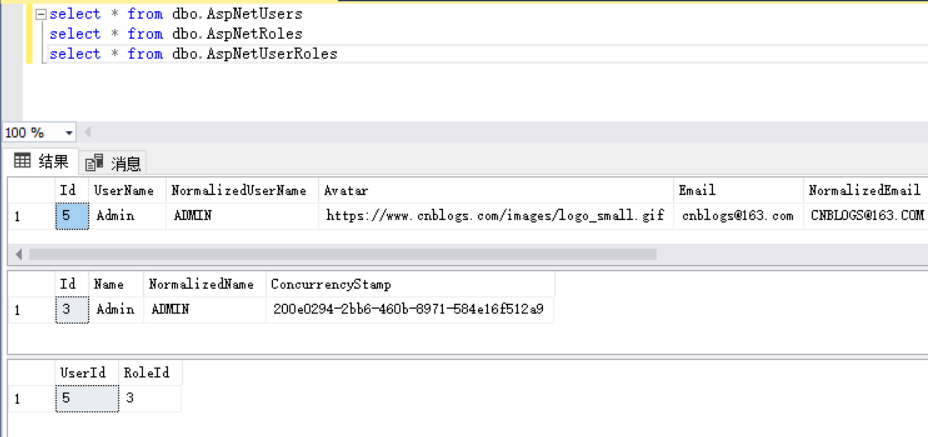identiyt的使用可以看之前的文章:https://www.cnblogs.com/nsky/p/10323415.html
之前的ids4授权服务器都是用的in-men方式把数据添加到内存,
现在应该改成identity对接数据库操作,因为之前的代码有,就不一一创建了
nuget包:IdentityServer4.AspNetIdentity
那么之前的TestUser以及TestUserStore都要替换掉
AddAspNetIdentity<ApplicationUser>()
那么Profile是什么? Profile就是用户资料,ids 4里面定义了一个IProfileService的接口用来获取用户的一些信息,
主要是为当前的认证上下文绑定claims。我们可以实现IProfileService从外部创建claim扩展到ids4里面。
定义一个ProfileServices类继承IProfileService
using AuthorizationServer.Models; using IdentityModel; using IdentityServer4.Models; using IdentityServer4.Services; using Microsoft.AspNetCore.Identity; using System.Collections.Generic; using System.Linq; using System.Security.Claims; using System.Threading.Tasks; namespace AuthorizationServer.Services { /// <summary> /// Profile就是用户资料,ids 4里面定义了一个IProfileService的接口用来获取用户的一些信息 /// ,主要是为当前的认证上下文绑定claims。我们可以实现IProfileService从外部创建claim扩展到ids4里面。 /// 然后返回 /// </summary> public class ProfileServices : IProfileService { private readonly UserManager<ApplicationUser> _userManager; private readonly RoleManager<ApplicationRole> _roleManager; public ProfileServices( UserManager<ApplicationUser> userManager, RoleManager<ApplicationRole> roleManager) { _userManager = userManager; _roleManager = roleManager; } public async Task<List<Claim>> GetClaimsFromUserAsync(ApplicationUser user) { var claims = new List<Claim> { new Claim(JwtClaimTypes.Subject,user.Id.ToString()), new Claim(JwtClaimTypes.PreferredUserName,user.UserName) }; var role = await _userManager.GetRolesAsync(user); role.ToList().ForEach(f => { claims.Add(new Claim(JwtClaimTypes.Role, f)); }); if(!string.IsNullOrEmpty(user.Avatar)) { claims.Add(new Claim("avatar", user.Avatar)); } claims.Add(new Claim("姓名", "tom")); return claims; } /// <summary> /// 获取用户Claims /// 用户请求userinfo endpoint时会触发该方法 /// http://localhost:5003/connect/userinfo /// </summary> /// <param name="context"></param> /// <returns></returns> public async Task GetProfileDataAsync(ProfileDataRequestContext context) { var subjectId = context.Subject.Claims.FirstOrDefault(c => c.Type == "sub").Value; var user = await _userManager.FindByIdAsync(subjectId); context.IssuedClaims =await GetClaimsFromUserAsync(user); } /// <summary> /// 判断用户是否可用 /// Identity Server会确定用户是否有效 /// </summary> /// <param name="context"></param> /// <returns></returns> public async Task IsActiveAsync(IsActiveContext context) { var subjectId = context.Subject.Claims.FirstOrDefault(c => c.Type == "sub").Value; var user = await _userManager.FindByIdAsync(subjectId); context.IsActive = user != null; //该用户是否已经激活,可用,否则不能接受token /* 这样还应该判断用户是否已经锁定,那么应该IsActive=false */ } } }
ConfigureServices也要修改:

这样的话。配置基本上就完成了
接下来用Hybrid Flow实现试试
因为CodeIdToken 有2种方式返回profile
ResponseType改成 code id_token
options.ResponseType = OpenIdConnectResponseType.CodeIdToken;
//设置从UserInfoEndpoint获取claims信息
options.GetClaimsFromUserInfoEndpoint = true;
获取后映射到claims
options.GetClaimsFromUserInfoEndpoint = true;
options.ClaimActions.MapJsonKey("sub", "sub");
options.ClaimActions.MapJsonKey("preferred_username", "preferred_username");
options.ClaimActions.MapJsonKey("avatar", "avatar");
options.ClaimActions.MapCustomJson("role", job => job["role"].ToString());
这样会返回的access_token信息也包含了该信息,
但如果claims过大,那么access_token也会很大
授权成功了。在view页面
引入:@using Microsoft.AspNetCore.Authentication
并获取

这样就会有ProfileServices.cs类中获取的clsims了

access_token中同样会有

id_token中是不会有的
上面说了,profile的cliams信息是通过access_token访问UserInfoEndpoint获取的
我们也可以通过postman试试

而这些信息都是从数据库读取出来的

如果不设置GetClaimsFromUserInfoEndpoint=true
它默认是false
那么我们想得到怎么办,
1:可以自己用access_token去获取一次
2:授权服务器client设置 AlwaysIncludeUserClaimsInIdToken=true
这样就会把返回的profile信息包含在idtoken中,好像idtoken也会有很大的可能
好了。试试效果,这样其实idtoken和access_token都返回了profile信息